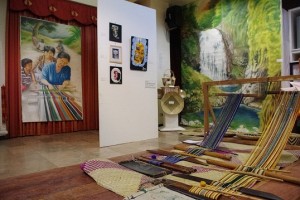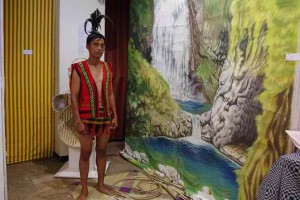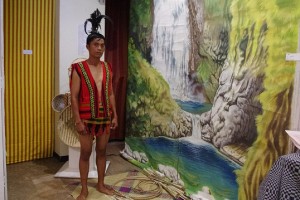RUBEN Ines Vallejos hardly blinked an eye while staring at the lineup of visitors at the visual arts exhibit he and 16 other artists from indigenous tribes of northern Philippines put up through the help of the Kalinawa Art Foundation (KAF).
The 44-year-old painter who hails from the interior village of Adams, Ilocos Norte said “it’s a dream come true” to be a part of the second Indigenous Peoples’ (IPs’) visual art exhibit held recently at the Ilocos Norte Capitol auditorium.
Seeing his art portraits of fellow indigenous people doing their craft, such as traditional wine making using wild fruits which are abundant in his village, walis (soft broom) making, weaving and basketry, made him proud of his roots.
Also on exhibit was a giant oil canvass of the Masi hanging bridge and the magnificent waterfalls surrounded by thick forest. From an artist’s eye, they come alive.
And who says fine arts is only for the rich?
Well, not in Vallejos’ case.
“They say ‘fine arts’ is a hobby for the rich,” he said. “It’s expensive to enroll in an exclusive school but I thank God, he made a way to (make me) realize my dream.”
Vallejos said he was lucky enough his former school—the Mariano Marcos State University’s Fine Arts school—then in Paoay, Ilocos Norte honed his talent through a scholarship grant.
“At (a) young age, I really loved to draw despite the difficulties and discouragement of some peers,” he recalled. “It’s the only subject I know (where) I excelled in class.”
Vallejos said the famous painter Juan Luna from Badoc, Ilocos Norte, where his father came from, was his “idol.”
The KAF, established in 2006, has been going around the country to promote the development of IPs’ visual arts.
 In partnership with the provincial government of Ilocos Norte, the KAF launched the second annual Indigenous People’s Art exhibit from Feb. 4. to Feb. 9. The participating artists were members of tribal groups from the towns of Adams, Dumalneg and Nueva Era.
In partnership with the provincial government of Ilocos Norte, the KAF launched the second annual Indigenous People’s Art exhibit from Feb. 4. to Feb. 9. The participating artists were members of tribal groups from the towns of Adams, Dumalneg and Nueva Era.
Executive Director Raquel Palma Gil said the foundation has been holding visual art exhibits to help promote the art works of IPs, which not so many people in the community may not be aware of.
“Our main thrust is to showcase the art works of artists who are members of tribal groups,” Palma Gil said. “This way, their culture will be preserved and shared with the rest of the country and the world, and can even provide economic benefits to Indigenous Peoples.”
She noted that IPs have a deep sense of arts and culture and a unique one at that. However, their skills and talents are usually not fully developed because of lack of resources.
Instead of donations, Palma Gil said the Foundation “makes investments in creating opportunities and facilities to promote the talent of the artists and their art as a celebration of culture.”
Like Vallejos, more and more IP artists can make their dream come true if they do not give up and strive to make it happen.
“(After all,) it’s not the money (that we earn through participating in exhibits) but the opportunity of being recognized and to express ourselves to the community,” Vallejos said.

